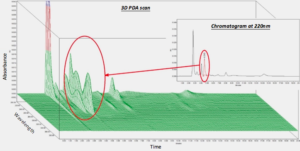How Your DAD Became the Sherlock Holmes of Analytical Chemistry!
Were you ever in a position to resolve hidden peak mystery in your laboratory? Did you ever struggle with some chemical entity buried under the main peak of your interest? Or maybe you were trying to develop a new method and you were looking for spectral purity of peaks? Well dear Watson, if your answer is YES then I hope you will enjoy reading my thoughts on how your DAD (Diode Array Detector) can help you and solve a mystery in analytical chemistry!
In my opinion, DAD is one of the most useful and powerful tools you can have in your lab, drawbacks – it can only be used in liquid chromatography (LC) analytical technique, and your compound must be able to absorb in the UV-vis range. Part of your molecule must contain so called chromophore. With the variety of detectors available on the market, it is hard to decide which one we should use; however, despite the different pricing, looks and features (mainly software-driven features) each DAD detector will do the same job with more or less sensitivity.
The main reason for the use of DAD (called by some PDA detector) in a lab is MORE. You might ask – what is MORE? MORE is more data, more understanding, more knowledge and these days more sensitivity, like Shimadzu M30 series and M40 series detectors.
Any DAD will collect 3-dimensional data of absorbance across defined wavelength range within specified runtime, giving us a full picture of spectral information in a single run. We can talk about aspects and functionality of DAD detectors for hours and there is a vast amount of papers and information on the web, all easy to find. What I want to do is resolve the Case like a real investigator! see below.
Case Debriefing:
During the development of an analytical chemistry method using LC instrument with UV detection (single channel mode), an Analyst encountered issues with one of the peaks of interest (peak at 4.5min). Peak signal to noise value was poor and most importantly peak resolution was not great. Additionally, due to the complex biological sample matrix, concerns were raised – should the peak at 4.5min be a pure peak or has some potential coelution occurred, which is invisible.
The answer was simple – samples were run using the same instrument setup as the original method with single channel UV detector only, but DAD detector was applied to help us. DAD acquired 3D scans and the below image appeared.

Using 3D spectrum data collected shown above.
- You can enhance your chromatographic assessment of peak at 4.5min and collect data at approx. 290nm
- Nearly all other peaks present are dying at approx. 280nm (losing their signal) – check other peaks slopes going down!
- This way you have a very specific chromatogram collected at 290nm for only 1x compound (mostly peak at 4.5min)
- Additionally, check spectral peak purity value – this will give you confidence that no other peaks are eluting underneath your peak at 4.5min. Nearly every software package offers peak purity assessment.
Using your DADs help in 1x single run we found optimum conditions for peak at 4.5min to enhance peak response in a very specific way. No matrix concerns, improved signal to noise = improved response, specific method for our peak and no more resolution issues.
What do you think about your DAD now?
Now tell me, do you think that your DAD was helpful in our Case above? I know that DAD was very helpful, one simple run resolved all issues and concerns we had. The definite proof was obtained with confirmatory runs to close the case.
Is DAD helpful, can it become your go-to tool when unanswered analytical chemistry questions are asked? – no doubt it is, it can, and it should when your UV-vis needs a proper investigation.
 Written by Sebastian Jurek
Written by Sebastian JurekM.Sc Eng., Chromatography Application Specialist, Mason Technology.
Sebastian Jurek M.Sc Eng., Chromatography Application Specialist at Mason Technology with extensive experience in highly regulated pharmaceutical industry.
To learn more about LG, CG, LCMS, GCMS or to consult any other chromatography related query you may have, you can contact Sebastian via our contact us page or email Sebastian directly on sjurek@masontec.ie.
If you would like to stay in touch and receive updates on emerging and current laboratory technologies and receive our monthly blog posts register for our customer newsletter here.
RECENT POST
Introducing the Eppendorf Research® plus 4-Pack with e...
Apr 24, 2024
NewsMettler Toledo Launches New Generation of Laboratory Ba...
Apr 22, 2024
NewsMason Technology is one of Ireland's Best Workplaces&#x...
Apr 18, 2024
NewsWebinar: Thinking outside the mouse: ex-vivo dissection...
Apr 11, 2024
WebinarsUnderstanding Buffers in Liquid Chromatography
Apr 10, 2024
BlogExploring Texture Analysis in advancing Medical Device ...
Mar 26, 2024
BlogFreeze Drying Adviser Vol.2: Illustrated Toolkit for Ge...
Mar 13, 2024
White PapersSolvents Mixing Ratio in Liquid Chromatography
Mar 06, 2024
Blog
